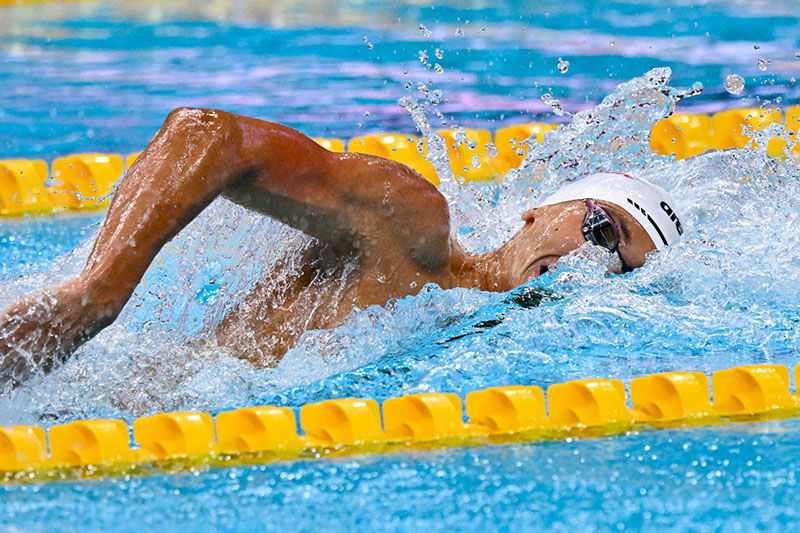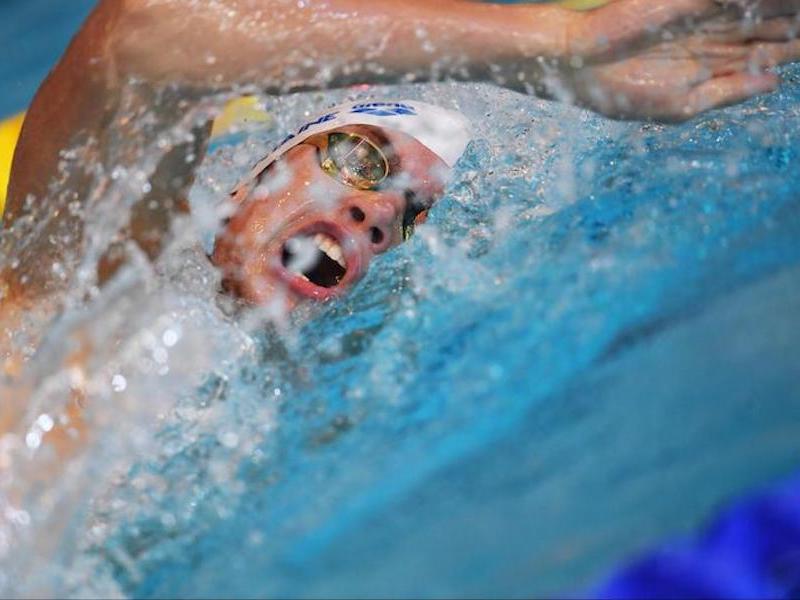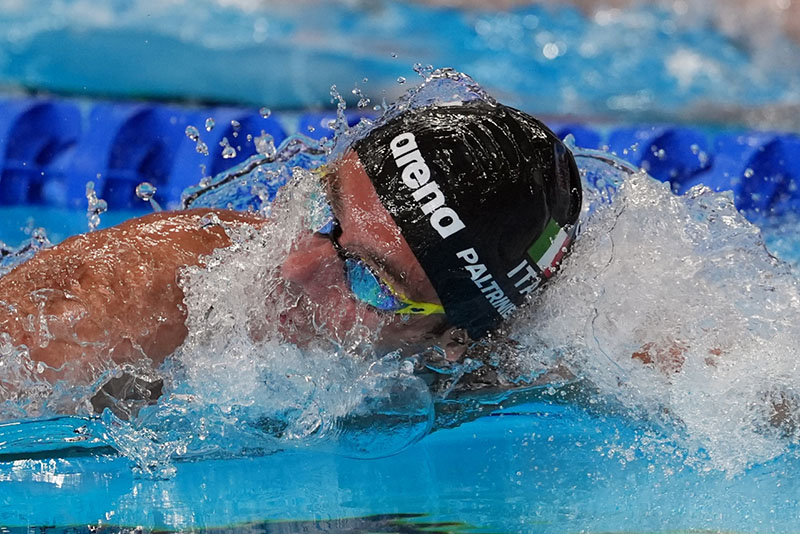Swim With Your Head: Improve Your Freestyle Head Position
Proper freestyle head position is crucial to your overall freestyle technique. Good head position will help you swim quickly and efficiently. One of the most common mistakes in freestyle is swimming with your head too high, which causes drag. The best way to improve freestyle head position is to focus on your form and environmental aspects of your swimming.
After reading this article, you will understand the appropriate head position to use while swimming freestyle. We will go over the role freestyle head position plays in the relationship between propulsion and drag during the different phases of your stroke cycle. Then, we will cover some common mistakes with head position and provide some training tips for you to practice. We will end with some pointers on how to optimize your environmental conditions, so they become conducive to practicing with good form.

The Fundamentals of Correct Head Position
Whether you are learning how to swim for recreation, a seasoned triathlete, or an Olympic swimmer, understanding proper freestyle head position is necessary. When you swim with the correct head position, you will move through the water more efficiently and with greater speed.
First, focus on holding your head and neck in a neutral position. As you swim, you should be looking at the bottom of the pool. Do not raise your head to look in the direction you are swimming. Raising your head will create drag and slow you down. What is more, holding your head in a raised position can lead to shoulder pain.
To avoid the issue of raising your head while you swim, imagine a line starting at the top of your head and continuing through your spine. The goal is to keep this imaginary line straight. If you were to raise your head, you would bend the line, and your head, neck, and spine would no longer be even.
Focusing on keeping a neutral neck position, looking at the bottom of the pool, and visualizing the imaginary line are great ways to develop the fundamentals of correct freestyle head position. Once you feel comfortable with the fundamentals, you can move on to the nuances of head positioning to optimize the relationship between propulsion and drag reduction.
Increase Propulsion and Decrease Drag

As a swimmer, water resistance is a constant. On the one hand, it is the element that allows you to pull through the water with each stroke to propel yourself forward. On the other hand, it is constantly at work against you and slows you down as you move through the water.
Your head position plays a vital role in the relationship between propulsion and drag. It is, after all, the foremost part of your body moving through the water, so it is essential to focus on proper form so you can swim with power and reduce frontal drag. Let’s go over the optimal freestyle head position to use during the different phases of your stroke.
Freestyle Head Position During the Propulsive Phase
As your arm pulls through the water to propel yourself forward, the lower back naturally begins to arch. The arching of your lower back is necessary so that you can exert more force through your pull.
Your head will naturally raise slightly as the lower back arches during your pull phase. This is acceptable because maximizing the amount of force generated during your pull phase is essential. However, you will still want to ensure that your eyes look downward and that your head does not raise too much. Don’t forget about your fundamentals as your swimming skills continue to improve.
Just because your head raises slightly during the pull phase of your stroke cycle does not mean it should stay up there. So, let’s move on to how you can reduce drag during a different part of your cycle.
Freestyle Head Position to Reduce Drag
There is a moment during your stroke cycle where your head should dip slightly underwater to reduce drag. Right as your arm enters the water in the recovery stage of your stroke, your head should be slightly submerged. During this moment, your body will be in the most streamlined position it can be during the freestyle stroke’s swimming phase.
Water resistance is greater at the surface than it is underwater. This is why the streamline during the underwater phase of a swim event is the fastest part of the race. When you allow your head to submerge itself slightly under the waterline while one arm is extended in front of you and the other is just completing its pull phase, you can reduce drag and maintain more of the forward energy provided from the pull phase.
Again, don’t forget your fundamentals. Only allow your head to dip just enough under the surface to reduce your drag. Dropping your head too low could increase drag.
How to Fix Common Head Position Mistakes

Improper head position can come from poor upper body position or from your hips dropping too low in the water. If you improve your body position in these two areas, it will be easier to maintain good head position while you swim.
Improve Head, Neck, and Upper Body Position
Freestyle head position is often related to incorrect placement of the upper body, or the neck, shoulders, and upper back. To correct these issues, you can try two different workouts.
Swim Workout
Use a swim snorkel and concentrate on the correct position of your head. Remember to keep a neutral neck position, look at the bottom of the pool, and visualize the imaginary line running through your head, neck, and spine.
Concentrate on correcting your stroke technique as well. Focus on a strong pull phase to generate good amounts of force. Also, keep in mind your freestyle hand entry technique. While concentrating on the pull and the hand entry, make sure you keep your head in the correct position.
Out-of-the-Water Workout
Exercise with resistance bands using workouts that help to improve your flexibility. As your upper body flexibility increases, you will find it easier to maintain proper head position.
Lift Your Hips
Your head may be in the incorrect position because your hips are dropped too low. When your hips are too low in the water, your head will naturally rise. This body position is not optimal for faster swimming and creates large amounts of drag. To correct the position of the hips and increase body positioning, try these workouts.
Swim Workouts
Here are three swim workouts you can use to improve your hip positioning.
- Train using a pullbuoy so you can begin to feel what it is like to swim with your hips close to the water. After swimming with the pullbuoy for a few laps, try swimming without it and focus on keeping your hips near the surface like they were when you were using the pullbuoy.
- Train your flutter kick. A powerful kick will help to keep your hips and legs up high in the water. Use a kickboard and focus on keeping your hips near the surface of the water during your kicking set.
- Practice sculling on your stomach with your hips near the surface of the water. Position your body parallel to the surface with your arms stretched out about 30 cm below the water level.
Without bending your wrist and with your palms facing outward, move your hands in opposite directions, toward the outside, slightly wider than your shoulder width. At this point, turn your palms inward and move them together. Focus on keeping your core tight and your hips high as you repeat this motion with your hands.
Out-of-the-Water Workout
Train your core. A strong core will help you keep the proper freestyle body position when swimming. Focus your training on exercises that improve core stability and endurance like planks, side planks, and L-sits.
Improve Your Environmental Factors
Crowded lanes are often a problem and can lead to the bad habit of lifting your head too high. To correct this mistake, try to improve the factors related to your swimming environment.
If you are swimming in your free time, try to take advantage of the time when the number of pool users is the lowest. If you are part of a team, try to find the best solutions for you and your teammates to be able to enjoy optimum swimming conditions and to correct your swimming technique.
If you can take up open-water swimming, this is a great place to practice your form. You can get away from crowded lane lines and discover wonderful places to swim in the wild. During an open-water swim, you will have plenty of room to work on your freestyle head position without worrying about bumping into other swimmers.
Now You’re Ready to Swim With Your Head
Now that you understand the proper freestyle head position, it’s time to head out to the pool (or open water). Remember to practice your fundamentals to the point where it becomes natural. Keep your eyes down, your neck neutral, and the imaginary line straight. After that, you can move on to the nuances of head position. Let it rise slightly during the power phase and submerge during the glide phase.
Something that might help keep your head down during your training is a good pair of goggles. Take a look at the full line of arena swim goggles.
Written by:
arena coaches
Swim coaches, trainers and experts will give you all kinds of tips for performing at your best in both training and races.







